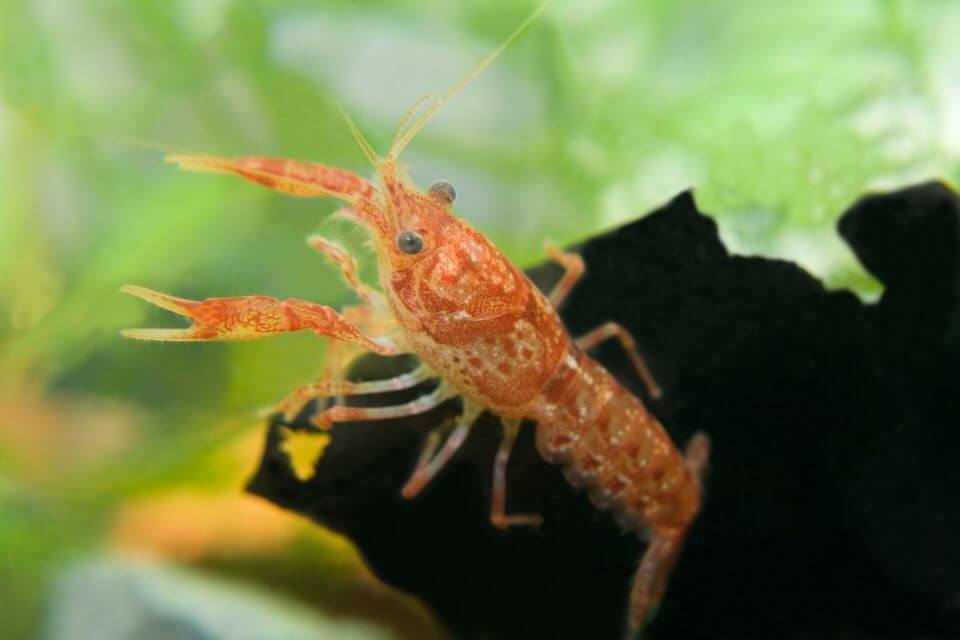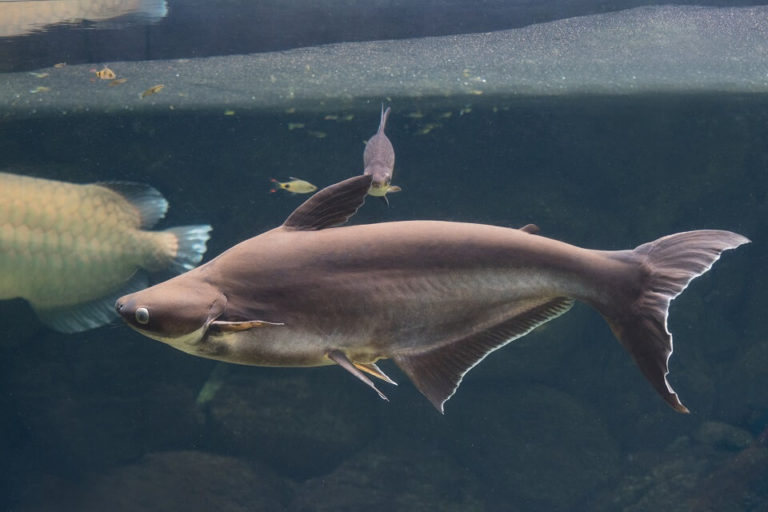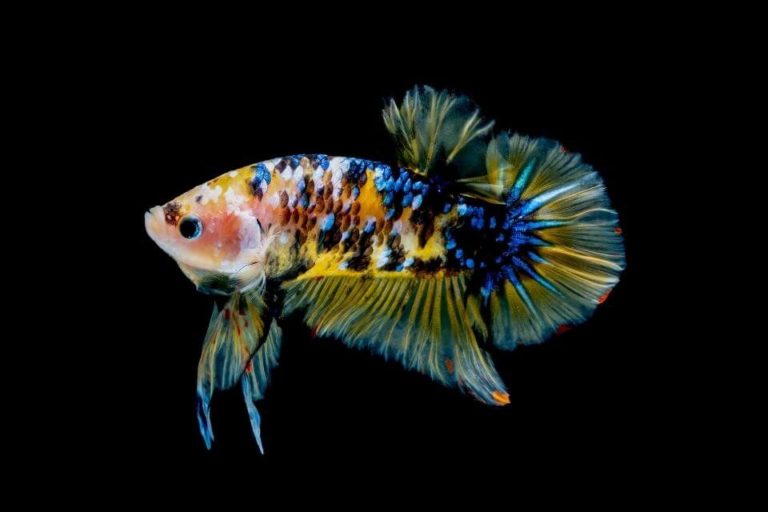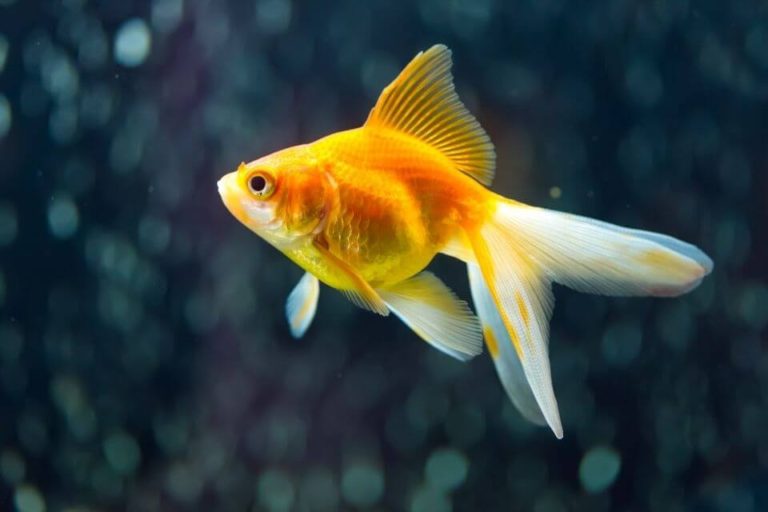The Complete Mexican Dwarf Crayfish Care Guide: Tank Mates & Feeding

Mexican Dwarf Crayfish is a beautiful freshwater crustacean species that will add an aesthetic appeal to your tank.
These crustaceans are popular among aquarists because they are easy to look after, peaceful, stunning, and keep your tank clean. If you want to add color to your aquarium, then Mexican Dwarf Crayfish is an ideal choice.
If you want to add this freshwater crustacean species to your fish tank, this Mexican Dwarf Crayfish care guide will provide you with all the information you need to know, including tank and water conditions, diet, tankmates, and breeding.
Species Overview
Mexican Dwarf Crayfish is scientifically referred to as Cambarellus patzcuarensis. They are small in size, and they look like lobsters but are not real lobsters. People called them freshwater lobsters because their appearance is pretty much similar.
There are different varieties of Mexican Dwarf Crayfish. These include Orange Crayfish, Blue Brazos Dwarf Crayfish, and CPO Crayfish.
They are from the Cambaridae family and originate from Mexico and some parts of the Southern United States. They are primarily found in slow-moving bodies of water that are shallow with vegetation, such as rivers, streams, lakes, and ponds.
Although these crustacean species are hardy and can survive in a wide range of water conditions, they require a unique process when adding them to your aquarium.
First, you need a robust filtration system to change your water before adding Mexican Dwarf Crayfish. This increases the chances of success.
When setting up a Mexican Dwarf Crayfish fish tank, follow the instructions provided in the letter, and you should be able to enjoy your pets for 2 to 3 years.
For a healthy and optimal lifespan, ensure that you replicate their natural habitat and provide them with plenty of hiding places, such as rocks, logs, plants, and wood.
Typical Behavior & Temperament
Mexican Dwarf Crayfish are scavengers and love to feed on anything that comes their way. They will burrow through the sand, eating any leftovers and algae. They love playing and hiding beneath the rocks, caves, and plants.
And most of the time, you will find them moving about the aquarium, thus, making your afternoon enjoyable and relaxing.
They are significantly weakened during molting, so the hiding places provide a place to hide and recuperate as the shell grows back. Young Crayfish molts 3 to 4 times each week, while adult Crayfish molts once or twice per year.
If a crayfish had lost its limbs, it would regenerate during molting. What’s better is that you do not need to clean the tank of the exoskeleton because they feed on them, which is a good source of calcium.
Female Mexican Crayfish is an excellent example of a parent and a mother as they lay the eggs, fertilize using the male sperm and protect them till they are old enough to fend for themselves.
Although Mexican Dwarf Crayfish can swim, most of the time, you will find them crawling and burrowing in the sandy substrate. And their movements are unpredictable, meaning it’s difficult to capture them.
For instance, when they are in danger, they bend their Pleons together with Telson, enabling them to move backward swiftly.
You do not need to clean your tank because they feed on any leftovers, algae, and their exoskeleton, thus why they are nicknamed “tank janitors.” Mexican Dwarf Crayfish are pretty tranquil, but sometimes you will find them intimidating their tankmates.
Mexican Dwarf Crayfish Size
These crustacean species grow up to 2 inches, equivalent to 5.1 cm, and most times, you will find that their size ranges between 1.5 and 2 inches. On the other hand, other Crayfish species are three times the size of Mexican Dwarf Crayfish.
Juvenile Mexican Dwarf Crayfish are very tiny as they are about an inch long.
Mexican Dwarf Crayfish Lifespan
They have a short life lifespan of approximately 1.5 to 3 years. However, dwarf Crayfish have been observed to live longer in rare instances, especially when provided with optimal conditions.
And like any other crustacean or freshwater fish, the number of years they live depends on several factors, the main one being optimal living conditions. However, if you provide them with poor living conditions, diet, and poor water conditions, their health is affected, shortening their lifespan.

Appearance, Colors, And Special Markings
Mexican Dwarf Crayfish has a bright orange color, which makes it stand out in your fish tank. Sometimes you will see red hues. However, on the top part of their bodies, they have dark orange stripes and spots.
They are also nicknamed mini lobsters because they are small, and their shape resembles lobsters. Their bodies are encased in a hard shell and have a longer tail that allows them to be great swimmers.
When you look closely, you will see that the tail has small fins referred to as swimmerets, and they provide the Crayfish with control while swimming around the tank.
They have a pair of 5 limbs in the span of their short body (2-inch), hence why they molt often. The first four pairs are used to walk the bottom of the tank, while the last pair is used as pinchers/claws.
Although the pinchers can inflict a world of damage, Dwarf Crayfish are small; thus, they cannot do much damage. That is why it is possible to house them with other fish.
They have a set of antennae on their head, which helps them smell food and feel out their surroundings. Also, these Crayfish species have large black eyes that bulge outwards.
Mexican Dwarf Crayfish Care
Mexican Dwarf Crayfish are hardy, and thus can survive in a wide range of environments, making them perfect for beginners and expert aquarists. They have a good adaptation and will keep your tank clean.
However, it is always good to stick to the care instructions.
Although they are good tank cleaners, it is recommended that you clean your fish tank at least once a month. Do not use chemicals or soap-based materials since any residue could be detrimental to your fish’s health.
Instead, dip a cloth in warm water and wipe the interior walls of your tank. You should also wash the substrate under running water, and don’t forget to wash the decorations.
When cleaning the tank, put your Mexican Dwarf Crayfish in an enclosed compartment such as a bucket to prevent them from escaping.
Like any other freshwater fish, this Crayfish species does not thrive in poor water conditions and poor diet. So, ensure that you provide them with optimal care if you want to enjoy watching them for an extended period.
– Mexican Dwarf Crayfish Tank Size
Mexican Dwarf Crayfish are small in size; thus, you can house them in a nano tank. However, most people prefer to use a large tank of at least 5 or 10 gallons to give them enough space to move around.
Furthermore, a bigger tank will provide you with the opportunity to add a few tankmates. A bigger tank ensures that they have enough hiding places when they are molting and suffer no stress due to a cramped living situation.
– Tank Setup
When setting up the tank for Mexican Dwarf Crayfish, you should pay close attention to the substrate and decorations. This is because crayfish love burrowing in the sand and hiding, especially during molting when they are weak.
Molting occurs almost three times a week for young Dwarf Crayfish, while adult crayfish molt about 2 to 3 times a year.
Although you may notice the hard shells floating around in the tank, do not worry about cleaning them because Mexican Dwarf Crayfish feed on them as it’s a good source of calcium which is vital in growing their hard shell.
So ensure that you include large logs, rocks, artificial caves, and driftwood at the bottom of the tank. When choosing a substrate, you should either use fine sand or small gravel.
– Suitable Plants
You should also add a lot of live aquarium plants. Ensure they are edible to prevent the death of your Dwarf Crayfish since they love snacking.
And Mexican Dwarf Crayfish thrive well when the tank is full of different aquarium plant species. Some plants to add to your tank include Java Moss and Hornwort, as they are strong.
– Water Parameters
Mexican Dwarf Crayfish are not picky about their living conditions as they do well in different habitats. However, you must keep the water within the acceptable parameters for a long and healthy life.
Like most freshwater fish and crustaceans, poor water conditions threaten their health and life span.
They are found in shallow, slow-moving bodies of water with lush vegetation. So, ensure that you replicate that in your tank. So, check the filtration system to ensure that the Crayfish’s water current is not too strong.
Due to their small size, cover the filter so that you do not lose any Dwarf Crayfish. The water must also be warm, so it would be best to outfit the aquarium with a water heater.
Before introducing your Crayfish to your tank, you must ensure that the water meets the following parameters. But firstly, if you are adding them into a community tank, you must first change the water.
- Water temperature: Between 60 – 75 degrees Fahrenheit
- The pH levels: Must be between 6.5 and 8.0
- Degree of water hardness (dKH): Should be between 6 and 12 dKH
Although Mexican Dwarf Crayfish are tank cleaners, it’s best to have a robust filtration system. Usually, most people prefer to use hang on Back (HOB) and sponge filters.
Also, change the water regularly ( every week) because they do not do well in water with high levels of ammonia and nitrates.
– Common Possible Diseases
Mexican Dwarf Crayfish is a crustacean, and fortunately, crustaceans are not affected by freshwater diseases such as ICH, and their thick, hard shells protect them from most issues.
However, they are at risk of being infected by a condition caused by water mold, known as Crayfish Plaque. The disease is highly contagious, and worse is it can also be spread to other invertebrates in your aquarium.
Lucky for you, it doesn’t develop in a community tank, but only if you introduce already-infected Crayfish in your aquarium. So, before adding any new crayfish to your tank, check to ensure that they are not infected with the plaque.
During molting and breeding, your Mexican Dwarf Crayfish are prone to stress, which can inhibit their health, preventing them from living to their full lifespan.
To avoid introducing infected Crayfish to your fish tank, only buy from reputable breeders and never add Crayfish from the wild into your tank. Also, maintain optimal water conditions as poor water conditions promote the growth of mold.
Also, ensure that the tank conditions and the habitat mimic the fish’s natural habitat. We all know that poor water conditions and less than ideal habitat result in stress, diseases, and a short lifespan for your fish.
Mexican Dwarf Crayfish Diet And Feeding
Mexican Dwarf Crayfish are omnivorous, meaning that they eat both meat and plants. They are scavengers, so not picky about what they put in their mouth. These Crayfish species are also suitable for cleaning the tank as they also feed on algae and any leftovers.
They also feed on their shells after molting any dead tank mate, thus, the reason they are referred to as “tank janitors.” So do not stress about what to feed your Mexican Dwarf, but always make sure to provide them with a balanced diet.
You can also supplement their food with food pellets, algae wafers, and any other commercial food for invertebrates. Ensure that their diets consist of protein-rich live or frozen foods such as bloodworms, blackworms, brine shrimp, and earthworms.
The vegetables include lettuce, peas, cucumbers, and zucchini.
Mexican Dwarf Crayfish are bottom dwellers, so make sure that all the food you are using can sink to the bottom of the tank. Besides, be careful not to overfeed your fish as the leftovers will impact the water conditions, which is detrimental to other marine life in your aquarium.
Make it a point to wash the vegetables before feeding them to your fish. They are also classified as cannibals as they eat their young ones, ensuring that the mother and the eggs are moved to a breeding tank until they hatch and mature during breeding.
When you keep invertebrates as pets, ensure that you check and confirm that anything you add to your community tank does not contain copper as it is harmful to invertebrates.
Mexican Dwarf Crayfish Tank Mates
Mexican Dwarf Crayfish are bottom dwellers, so it would be best to use fish that reside in the top part of the fish tank. This ensures that they have less chance of meeting and engaging in a fight.
Do not house your Crayfish with other large or aggressive fish because it increases the chances of a dispute. For instance, if you put them with Orange Dwarf, the chances of them being eaten are high, and if you house them with Cichlids, your Mexican Dwarfs will be feasted on.
Although Mexican Dwarf Crayfish is considered a peaceful fish, it’s possible to find aggressive or territorial tendencies. So make sure not to use timid tank mates such as dwarf shrimp or tiny snails as they will be devoured.
You can opt to use small fish that are highly active such as rainbow fish or neon tetras, but because of Mexican Crayfish scavenging nature, there is no telling what will happen when their claws come in contact with the fish. However, you will never find them eating other fish.
The best and most recommended tankmates for Mexican Dwarf Crayfish include:
- Congo Tetra
- Chili Rasbora
- Swordtail Fish
- Platy Fish
- Rummy Nose Tetra
- Celestial Pearl Danio
- Ember Tetra
- Hatchetfish
- Sparkling Gourami
- Guppies
- Harlequin Rasbora
Gender Differences
They have five pleopods, and the first pair is soft in females while stiff in males. Pleopods are the limbs located along the fish’s abdomen.
Mexican Dwarf Crayfish Breeding
Breeding Mexican Dwarf Crayfish is straightforward because you are all set as long as you have a male and a female.
Their breeding process is unique as the male pins down the female using his chelae and then deposits the sperm into the female. They usually stay in that position for about 20 minutes.
However, fertilization does not occur immediately, as the female carries the eggs for 2-4 weeks until she feels ready to lay the eggs.
The female Mexican Dwarf Crayfish lays about 20- 60 eggs dark to brown in a safe place. She then places the eggs in her swimmerets, and fertilizes them while releasing thin mucus layers to cover and protect them.
Swimmerets are the limbs below the tail. She also keeps the eggs clean by pushing water to them while ensuring they have sufficient oxygen levels.
Female Mexican Dwarf Crayfish is a nurturer as she takes care of the eggs till they are ready to hatch in about 3-4 weeks after they are laid. She then takes care of the juveniles until they are big enough to hunt for food.
It is recommended that you move them to a separate tank till they are big enough to join the community tank, but if you do not have the facilities, you can ensure that you put enough decorations in the tank to provide them with hiding places.
They are pretty small, less than an inch long, making them vulnerable to other fish.
When feeding juvenile Mexican Dwarf Crayfish, don’t stress because they can scavenge the floor for the leftovers until they can eat what the big Crayfish are eating. Ensure that you place food at different sections of the tank to ensure that they are getting enough since they are not fast enough.
Origin And Distribution
From its name, you can deduce that this colorful Dwarf Crayfish originates from Mexico. However, you can also find them in the Southern parts of the United States.
Mexican Dwarf Crayfish are primarily found in shallow, slow-moving water bodies, such as rivers, streams, ponds, and lakes with vegetation. That they are hardy makes it possible for them to survive in a wide variety of environments.
However, it is hard for wild Mexican Dwarf Crayfish to survive in an enclosed environment; therefore, the ones used in aquariums are bred privately and then sold worldwide.
Frequently Asked Questions
Please review below questions and answers below that might help you more to understand the Mexican Dwarf Crayfish.
Are Mexican Dwarf Crayfish Aggressive?
Yes. Although they are known to be peaceful, they have claws. Male Mexican Dwarf Crayfish tend to be aggressive, especially towards their own. Make sure not to overpopulate your fish tank.
Are Dwarf Crayfish Hardy?
Yes. Mexican Dwarf Crayfish can survive in a wide range of water conditions, and they are fed on both meat and plants, making them easy to take care of.
Do Dwarf Crayfish Need Land?
No. They have to be submerged at all times and do not need land. However, they are escapists, so ensure that your tank is covered and does not have any holes.
Do Mexican Dwarf Crayfish Need A Heater?
If your tank is outside, yes, but if you are housing it indoors and the temperatures are stable, you don’t need to add a heater.
Can We Keep Mexican Dwarf Crayfish With Shrimp?
It is not recommended to house Mexican Dwarf Crayfish with shrimp. This is because the Crayfish may regard the shrimp as a snack. However, since shrimp are faster than Crayfish, they may be safe but very risky.
Where Are Dwarf Crayfish For Sale?
Mexican Dwarf Crayfish has become popular in the aquarium market because of their stunning hue, peaceful nature, and ability to clean the tank.
If you are looking to keep Dwarf Crayfish, you can check with your local pet stores such as Pet Smart or Petco. Alternatively, you can buy it online from reputable aquarium fish breeders, and it will be delivered to your doorstep.
You might find individual fish breeders on online auctions such as eBay.com.
Get Ready To Have One
Mexican Dwarf Crayfish are a stunning addition to your fish tank. These freshwater crustaceans are easy to care for and are not picky about their diet, making them more appealing to aquarists.
If you are looking to add a freshwater crustacean to your fish tank, Mexican Dwarf Crayfish might be the best option for you to choose.







